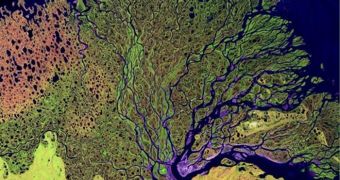The Arctic Ocean and surrounding areas are polluted with mercury from a number of sources, scientists at the Harvard University School of Engineering and Applied Sciences (SEAS) found in a new study.
The dangerous chemical is brought to the area by atmospheric forces such as winds, as well as by intricate river flow patterns in the Arctic region. The bottom line is that the element continues to accumulate in one of the world's most sensitive habitats.
The fact that rivers contribute to this type of pollution in this region was not known until now. Past investigations did establish that atmospheric influences were leading the mercury accumulations at this location, but failed to recognize the roles rivers played in this phenomenon.
One of the most significant implications the new investigation has is that mercury concentrations will continue to increase in the foreseeable future, as global warming and climate change lead to more ice melt in the Arctic. The phenomena also trigger shifts in river circulation patterns.
SEAS investigators worked closely with colleagues at the Harvard School of Public Health (HSPH) for this study. Details of their work were published in the May 20 issue of the journal Nature Geoscience.
“The Arctic is a unique environment because it's so remote from most anthropogenic (human-influenced) sources of mercury, yet we know that the concentrations of mercury in Arctic marine mammals are among the highest in the world,” lead author Jenny A. Fisher explains.
“This is dangerous to both marine life and humans. The question from a scientific standpoint is, where does that mercury come from?” the expert adds. She holds an appointment as a postdoctoral fellow with the Atmospheric Chemistry Modeling Group and the Department of Earth and Planetary Sciences.
“In humans, mercury is a potent neurotoxin. It can cause long-term developmental delays in exposed children and impair cardiovascular health in adults,” adds the HSPH Mark and Catherine Winkler assistant professor of aquatic science and co-principal investigator, Elsie M. Sunderland.
Mercury is very dangerous because it does not break down easily. It can last in the atmosphere, ocean or animals for years, and it is cataloged as a persistent bioaccumulative poison. Already, fisheries around the world are complaining that this type of pollution is affecting their stocks.
Funds for the new research were secured through the US National Science Foundation's (NSF) Arctic System Science Program.
“Indigenous people in the Arctic are particularly susceptible to the effects of methylmercury exposure because they consume large amounts of fish and marine mammals as part of their traditional diet,” Sunderland explains.
“Understanding the sources of mercury to the Arctic Ocean and how these levels are expected to change in the future is therefore key to protecting the health of northern populations,” the expert concludes.

 14 DAY TRIAL //
14 DAY TRIAL //